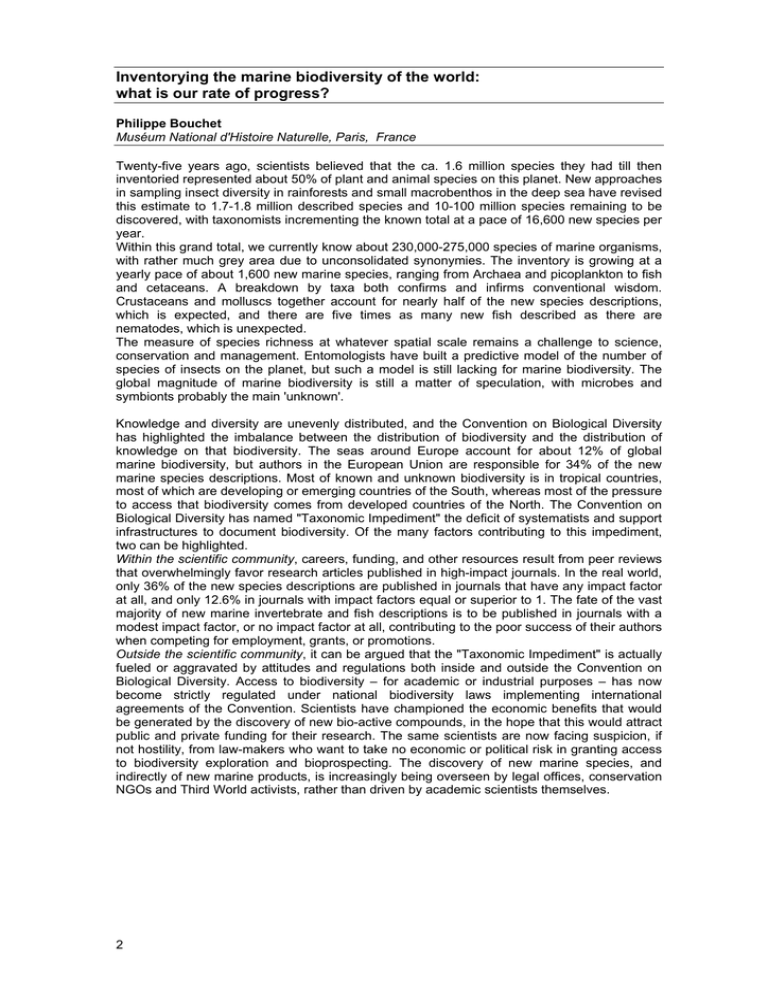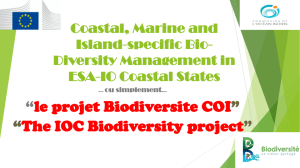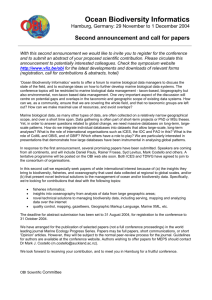Inventorying the marine biodiversity of the world:
advertisement

Inventorying the marine biodiversity of the world: what is our rate of progress? Philippe Bouchet Muséum National d'Histoire Naturelle, Paris, France Twenty-five years ago, scientists believed that the ca. 1.6 million species they had till then inventoried represented about 50% of plant and animal species on this planet. New approaches in sampling insect diversity in rainforests and small macrobenthos in the deep sea have revised this estimate to 1.7-1.8 million described species and 10-100 million species remaining to be discovered, with taxonomists incrementing the known total at a pace of 16,600 new species per year. Within this grand total, we currently know about 230,000-275,000 species of marine organisms, with rather much grey area due to unconsolidated synonymies. The inventory is growing at a yearly pace of about 1,600 new marine species, ranging from Archaea and picoplankton to fish and cetaceans. A breakdown by taxa both confirms and infirms conventional wisdom. Crustaceans and molluscs together account for nearly half of the new species descriptions, which is expected, and there are five times as many new fish described as there are nematodes, which is unexpected. The measure of species richness at whatever spatial scale remains a challenge to science, conservation and management. Entomologists have built a predictive model of the number of species of insects on the planet, but such a model is still lacking for marine biodiversity. The global magnitude of marine biodiversity is still a matter of speculation, with microbes and symbionts probably the main 'unknown'. Knowledge and diversity are unevenly distributed, and the Convention on Biological Diversity has highlighted the imbalance between the distribution of biodiversity and the distribution of knowledge on that biodiversity. The seas around Europe account for about 12% of global marine biodiversity, but authors in the European Union are responsible for 34% of the new marine species descriptions. Most of known and unknown biodiversity is in tropical countries, most of which are developing or emerging countries of the South, whereas most of the pressure to access that biodiversity comes from developed countries of the North. The Convention on Biological Diversity has named "Taxonomic Impediment" the deficit of systematists and support infrastructures to document biodiversity. Of the many factors contributing to this impediment, two can be highlighted. Within the scientific community, careers, funding, and other resources result from peer reviews that overwhelmingly favor research articles published in high-impact journals. In the real world, only 36% of the new species descriptions are published in journals that have any impact factor at all, and only 12.6% in journals with impact factors equal or superior to 1. The fate of the vast majority of new marine invertebrate and fish descriptions is to be published in journals with a modest impact factor, or no impact factor at all, contributing to the poor success of their authors when competing for employment, grants, or promotions. Outside the scientific community, it can be argued that the "Taxonomic Impediment" is actually fueled or aggravated by attitudes and regulations both inside and outside the Convention on Biological Diversity. Access to biodiversity – for academic or industrial purposes – has now become strictly regulated under national biodiversity laws implementing international agreements of the Convention. Scientists have championed the economic benefits that would be generated by the discovery of new bio-active compounds, in the hope that this would attract public and private funding for their research. The same scientists are now facing suspicion, if not hostility, from law-makers who want to take no economic or political risk in granting access to biodiversity exploration and bioprospecting. The discovery of new marine species, and indirectly of new marine products, is increasingly being overseen by legal offices, conservation NGOs and Third World activists, rather than driven by academic scientists themselves. 2



